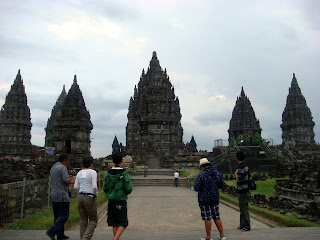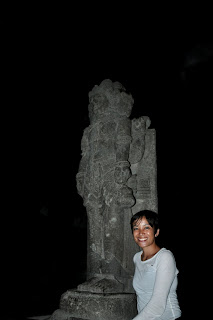 Nope, I didn’t run this time. I walked and climbed flights of stairs to appreciate every detail of the beauty of Candi Prambanan. When my colleagues learned I was visiting Jogjakarta (Yogyakarta), they egged me to visit Prambanan. And so I did. As the locals have told me, it’s another beautiful creation. Magestic and towering with its Hindu character.
Nope, I didn’t run this time. I walked and climbed flights of stairs to appreciate every detail of the beauty of Candi Prambanan. When my colleagues learned I was visiting Jogjakarta (Yogyakarta), they egged me to visit Prambanan. And so I did. As the locals have told me, it’s another beautiful creation. Magestic and towering with its Hindu character.Candi (temple) Prambanan is a few hundred years older than Borobudur. About 20-30 kilometers separates both temples. Prambanan boasts of three group of temples, the biggest and highest of which is Candi Siwa (Shiva) followed by the other temples representing the Hindu gods: Vishnu, and Brahma.
 Prambanan is said to have been constructed between the eight century and the ninth century A.D. In ancient time, it was the place where the capital of a kingdom-now known as “Keraton Boko” stood. According to our group’s tour guide, it is a pity that the ruins of the palace and temple can not give a hint about the existence of the kingdom and those who
Prambanan is said to have been constructed between the eight century and the ninth century A.D. In ancient time, it was the place where the capital of a kingdom-now known as “Keraton Boko” stood. According to our group’s tour guide, it is a pity that the ruins of the palace and temple can not give a hint about the existence of the kingdom and those whohad reigned there.

As I went from one small temple to bigger temples, It was obvious that reconstruction was being made. The guide told me that unlike Borobudur, which is getting its reconstruction and preservation fund from the Dutch government and UNESCO, Candi Prambanan is merely depending on allocation from the Indonesian government, thereby slowing the process of restoring the temples.


From one small temple to bigger temples, It was obvious that reconstruction was being made. The guide told me that unlike Borobudur, which is getting its reconstruction and preservation fund from the Dutch government and UNESCO, Candi Prambanan is merely depending on allocation from the Indonesian government, thereby slowing the process of restoring the temples.

As I went around, I couldn’t help myself admire and touch the reliefs and images depicting the story and legend of Ramayana. Feeling them with my fingers felt good to the touch. The images had about 41 frames at the Shiva temple. I studied this in high school and in my world literature class in university.

As I touched and traced the reliefs, the story run in my mind and how I loved the story. The other frames of reliefs in the temples told other stories of legends and reincarnation.

My experience with the tour guide in Borobudur wasn’t as pleasant, for I had to fill-in the blanks and infer what he was trying to tell me. However, the guide that we got for Prambanan was a lot better. Presumably in his sixties, he was a kind, gentle and a patient old man who zestfully answered my strings of questions. He impressed me by his command of English and figurative expressions. He had my attention. He knew his history and knew what he was talking about and above all, he made sense.


The tour ended but my mind was still playing all the images of the tour. Indeed it’s a special day, my d’ Day. The day I got to see two of the greatest temples ever built, on the very day that the stars were kind enough for me to meet and experience the best thing that ever happened to me.
Thank you for reading...'til the next journey.



































